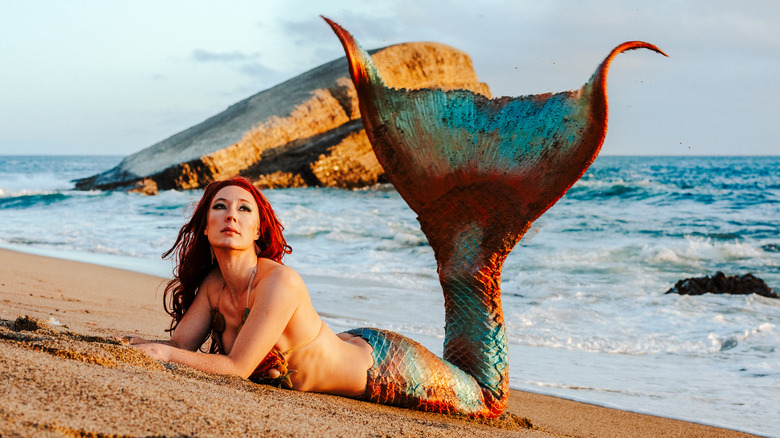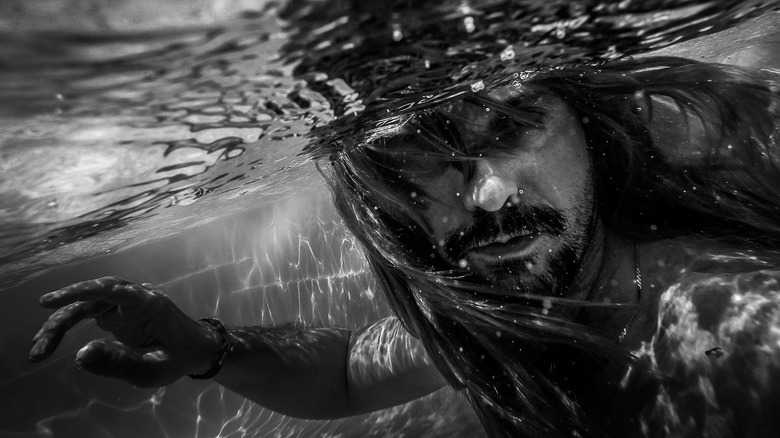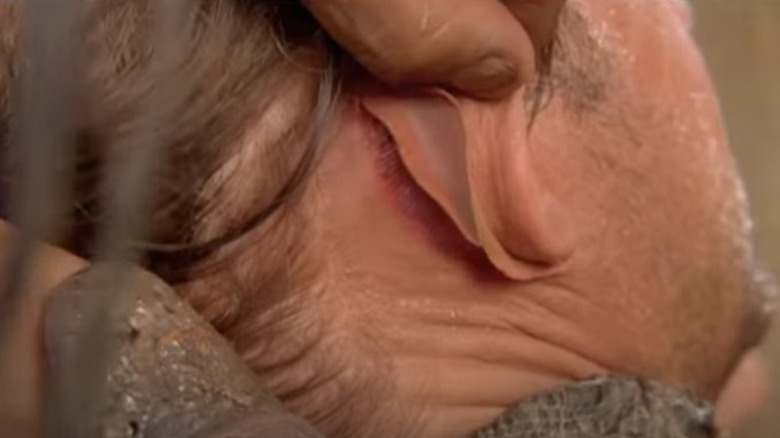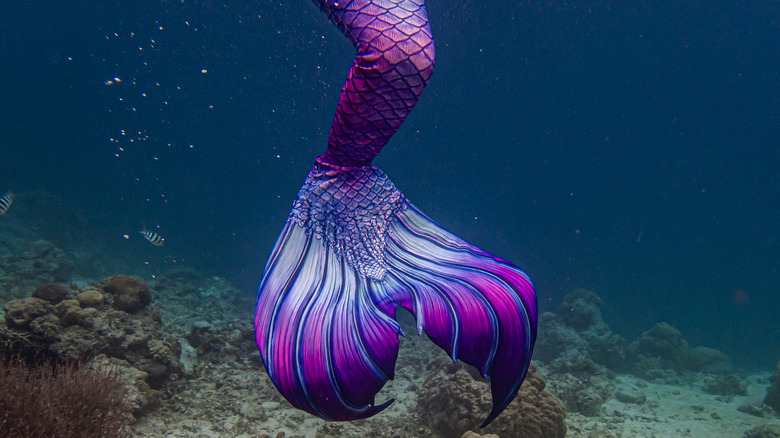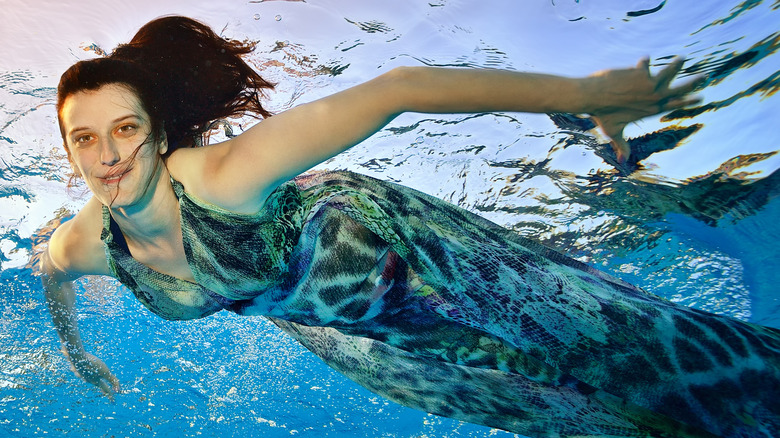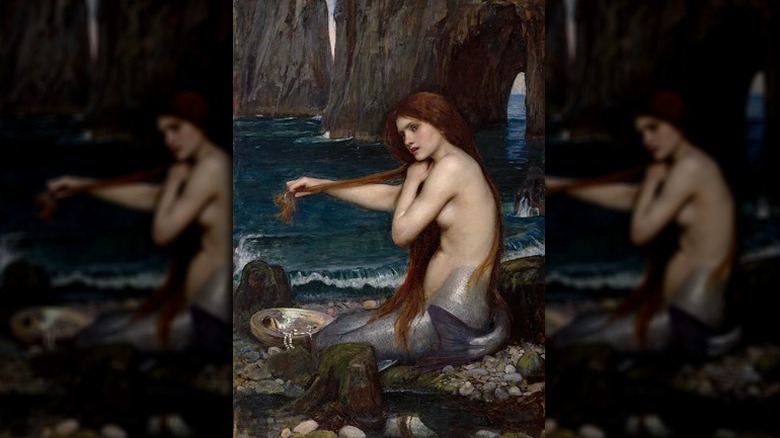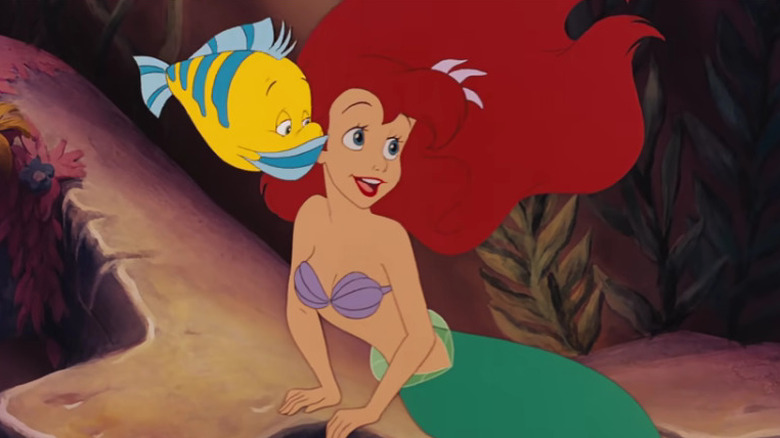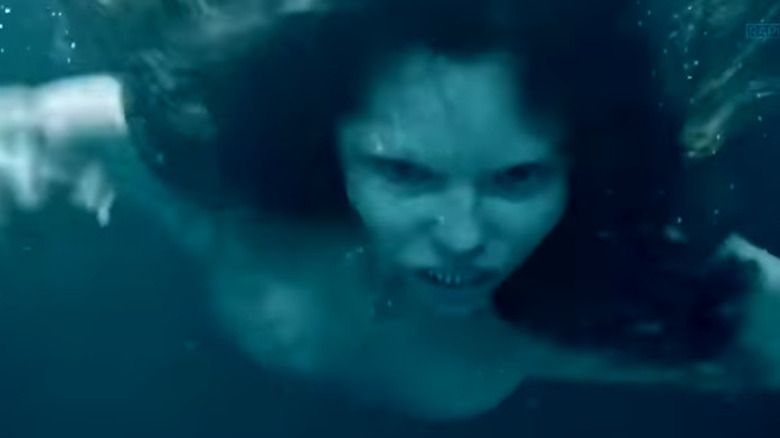Hollywood Vs. Science: What If Mermaids Were Real?
Mermaids are not real. Seductive yet dangerous, corporeal yet just out of reach, they personify the ever-shifting nature of water. And while some mythologists speculate mermaids are the anthropomorphization of manatees by (astonishingly pent-up) sailors, as per Smithsonian, the image of a beautiful woman hybridized with a fish is ancient and goes all the way back to antiquity. Greek historian Diodorus Siculus records the story of the Syrian goddess Derceto who in a fit of madness killed her lover. Grief-stricken, she flung herself into a lake, changing into a fish with a beautiful human head.
From there, the mermaid became a particularly popular Middle Eastern export. By the time Hans Christian Andersen wrote the archetypal "The Little Mermaid" in 1837, Pliny the Elder already described Nereids as mermaid-like, early Christian Irish legend gained a mermaid saint called Li Ban, and France had Melusine. Of course Hollywood was going to jump on the bandwagon and ended up diversifying the myth so much that Derceto wouldn't recognize herself.
But for giggles, what if mermaids were real? How close does Hollywood get to what a realistic mer-organism would be, one subject to natural selection and evolutionary forces? Animal Planet took the subject on when it broadcasted two mockumentaries, "Mermaids: The New Evidence" and "Mermaids: The Body Found," that were entirely fictional but done so well that viewers thought mermaids were actually real, reports CNN. Read on to see how close, or far, fiction is to fact.
The Song of the Sea
For the sake of pacing, most movie mermaids are portrayed as either already knowing a human language ("The Little Mermaid") or learning one within hours ("Splash"). Neither scenario is likely.
Firstly, mermaids would be so isolated from land that they never would have learned any human language. Moreover "native" mer-speech, and the organs involved with producing and articulating it, would have evolved in water, which the Smithsonian reminds us has a density greater than air. This would put mermaids on par with all other sound-producing sea creatures, none of whom exhibit the wide variety of sounds humans can produce. Dolphins click and "whistle", whales sing, and some fish species grunt. "Splash" is probably closest to the truth when the mermaid Madison, played by Daryl Hannah, gave her native name in a series of glass-shattering squeaks.
But Madison learning functional English in less than a day is pure movie magic. EF Education First estimates English would take upwards of 1,120 hours of around-the-clock study to be fluent, or around 46 solid days. So either Madison is the mermaid equivalent of a Star Trek-level supercomputer, or the writers had to figure out a way to get her talking as fast as possible and be funny doing it.
They Aren't All Maids
Hollywood mermaids are extreme; they are either militantly virginal ("The Little Mermaid" or "Aquamarine") or bloodthirsty wackadoos ("The Lure," "The Nymph," and "Pirates of the Caribbean: On Stranger Tides"). A definitive statement on how the species propagates is missing from the narrative, leading to much inconsistency.
The German coming-of-age flick, "Blue My Mind," depicts female progeny of a mermaid, though born human, becoming mermaids themselves upon puberty, suggesting that mermaids and human men are biologically compatible. While two creatures so radically different in body type producing viable offspring is improbable, the scenario actually mirrors the mythology. Tales of mermaids seducing and kidnapping men are common, although the legends never quite get into sexy-time details. Alternatively, "Mermaid Isle" posits mermaids infect human women with a transformative virus. None of this jives scientifically; fully-formed and fertile mermen must be out there ("Siren" gets it right!).
A study by researcher Sarah Otto states sex emerged a whopping two billion years ago, when life was still single-celled. Otto notes that for 99.9% of eukaryotes, creatures whose cells are enclosed and include a nucleus (which includes humans and, ostensibly, mermaids), it takes two to tango. Ironically, by adding mermen in its submarine franchise, painfully chaste Disney is spot on, however obliquely.
Lost Your Breath?
The "Mermaids" mockumentaries extrapolate on the Aquatic Ape Hypothesis, which states the reason humans are so hairless compared to other mammals is because at one point, our ancestors temporarily took to water long enough for natural selection to favor sleek skin. Mermaids are, therefore, humans that never went back to land.
And that means mermaids have lungs, organs that even whales (which have been aquatic for 50 million years) have yet to lose (our genus, Homo, is only 1.5 to 2.5 million years old). Mermaids would have to come up to breathe on the regular. If they did this, it can be inferred that sightings would have been so common, consistent, and from so many different sources across the planet that from the time records began to now, the existence of mermaids would be scientific fact, even if a specimen was never caught.
What about lungs combined with gills? Such a physical adaptation is depicted in "Waterworld," where Kevin Costner's protagonist, essentially a midpoint between human and merfolk, sports a set of gills behind his ears. This is not entirely Hollywood folly; after all, ears evolved from gills (via LiveScience), and evolutionary throwbacks, called atavisms, are not unheard of. However, in reality, only the lungfish has fully functional lungs and gills, but even it must return to the water to stay hydrated. No human-sized creature has two mutually exclusive respiratory systems.
Skin Deep
Like humans, mermaid skin color would depend on where they evolved. Provided mermaids settled where sunlight readily penetrates the sea, what oceanographers call the euphotic zone (via the National Ocean Service), then Hollywood gets it right by giving mermaids the pigmentations humans have according to latitude and ultraviolet light exposure (per a study in the Journal of Human Evolution). Simply put, the more UV light people get, the more their skin darkens to compensate over time. This is why humans come in a spectrum of colors. Things get interesting, however, the deeper one goes into the sea.
If mermaids are creatures of the lightless deep ocean, the aphotic zone, something to which the "Mermaids" mock-docs visually allude, they would have no pigment at all and be a ghastly shade of white, reports Smithsonian. Alternatively, if mermaids dwell in the "twilight zone," they, like many other creatures of that environment, would be a startling shade of red, a color that appears as black at that tenebrous depth to be a sort of camouflage.
Blending in may, in fact, be a vital evolutionary tactic. Unlike humans, mermaids would have to worry about predation (like sharks) coming from any direction. Consequently, like orcas, mermaids could be dark on one side and white on the other. From above, they would blend into the depths; from below, they blend into the sunbeams filtering down.
Presto-Chango!
In "Splash," "Siren," and "H2O: Just Add Water," a mermaid naturally transforms her lower half into legs once out of salt water and back to fins again in salt water. This seems to be some sort of reflex and not something the mermaid can control, and takes just seconds. No real-life creature can alter its body plan so profoundly so quickly.
In nature animals can change shape to the point where the beginning and final forms are unrecognizable from the other, but it is not a swift process. According to PetsHoods, it can take anywhere from a few weeks to several months for a tadpole to become a fully formed frog (depending on the species). Likewise, a caterpillar takes anywhere from 8 to 12 days to transform into a monarch butterfly. Keen observers will, of course, note that these changes are one way only. Beyond these examples, radical physical change has to rely on evolution, a process that can take huge amounts of time. The Smithsonian Museum of Natural History estimates it took 6 million years for Sahelanthropus, an early human ancestor, to even begin to walk on two legs.
For its part, Disney regards a mermaid as having an immutable body; Ariel relies on magic spells to become bipedal.
Fish Fingers
In an OurSpace article exploring the idea of intelligence evolving underwater, one of the more profound observations is that "once an intelligent species had evolved underwater, it would desire to better itself ... by inventing things to make life easier. To achieve this, said species would require a form of opposable digits (or tentacles!) in order to manipulate the materials around it to use as tools."
The Aquatic Ape Hypothesis easily accounts for a land-based mermaid ancestor taking to the sea with fully articulated human hands. Most depictions of Hollywood mermaids keep such an anatomical feature static and unchanged, along with the rest of the human torso. However, like any other creature, mermaids would be, over time, forced by their environment to adapt to the challenges of that environment thanks to natural selection.
According to Biography, using Michael Phelps as an example, swimmers get most of their power from their upper torsos. It can be inferred then that before aquatic apes developed powerful tails, they also would have depended on their arms and hands for forward thrust as much as they did for catching food. Natural selection would have maximized the upper limbs of these primitive mermaids for underwater locomotion, meaning that webbed hands or flippers similar to those of seals would appear, if not outright fins. "Siren" and the "Mermaids" mockumentaries take pains to show this evolutionary advantage.
Hairy Situation?
Long hair is one of the most enduring tropes of femininity. In writing for Science Focus, neuroscientist Christian Jarrett suggests this is because long hair on women connotes youth and fertility, while a similar article by Retox Magazine posits that long hair by itself is seductive. Certainly, one of the most alluring images of the mermaid is that of her combing her long, lustrous hair. Lord Tennyson wrote about it, and painter John William Waterhouse immortalized it. Even terrifically tressed Ariel of "The Little Mermaid" gets in on the act with a dinglehopper. The mermaids of "Splash," "Siren," "Blue My Mind," and "Aquamarine" likewise all sport epic manes. Assuming the Aquatic Ape Hypothesis holds water, mermaids would indeed have the hair that is a defining trait of all mammals (per DK findout!). They just would not have the kind of hair Rapunzel would kill for.
Aquatic mammals are practically hairless. Dolphins and whales are both born with hair, but it falls out soon after birth (per Whale Facts). Another sea mammal, the walrus, has also lost the majority of its fur save for a thin, sparse coat and whiskers (via Walrus World). Mermaids would likely be just as depilated. If mermaids actually descend from fish, they would have no hair at all at any stage of their lives.
Bodies of Water
The Aquatic Ape Hypothesis makes it impossible for mermaids to have the lower torso of a fish, with scales and webbing. Rather, their lower bodies would resemble something more along the lines of the taut-skinned physiology of marine mammals like dolphins and whales, an example of convergent evolution. Basically, this theory states that if two entirely different species come to reside in the same environment, evolutionary pressure from that environment will eventually make those species look very similar. It explains why fish and whales look alike, even though they are from completely different lineages.
But for argument's sake, let's assume mermaids are indeed an advanced evolutionary form of piscine. If this is the case, it would mean the mermaid lineage struck out on its own branch on the Tree of Life after fish had already developed "lobed" fins but before they first walked on land, a point scientists believe to be 375 million years ago (via NPR). That would explain the tail, but then the human upper torso needs explaining.
Here, convergent evolution falls flat. Dry land and the ocean are two very different environments, and fish lineages that remained in the sea would have remained fishlike. Land animals ultimately descend from lobed-finned fish, notes NPR, but those stubby, rudimentary limbs remained as fins if their owners remained oceanic, like the coelacanth. All this is to say that fish-descendent mermaids would never have evolved out of the "mer" stage.
Ocean Power
In "The Abyss," mermaid-like aliens are so scientifically advanced they can manipulate water itself. In the end-scene of "Splash," the camera pans to a brightly-lit underwater city, connoting artificial illumination at the very least. And in "The Little Mermaid," the city of Atlantica is composed of massive coral towers of a set design that suggest biotechnology (provided that magic isn't being used). It would seem that mermaids have some pretty sweet tech, all which leads to the simple question of "how'd they do that?"
The quick answer is that they didn't. As an article at Big Think points out, any present-day technology is the end-result of a long process of innovation. Humans could not have reached the Space Age or even a steam engine had fire not been discovered first. A water environment would act as a break for many terrestrial forms of energy and make them unavailable to a submarine species: Electricity would be lethal, fire is impossible, and hydrothermal power sources would boil a mermaid alive before she could get close enough to harness it. Combustion would not be entirely out of the question; Thermite, a highly reactive mix of iron oxide and aluminum, can burn under water, but even it needs an open flame to get going and requires a thorough knowledge of modern chemistry.
Mermaids would be Stone Age people, armed with spears and clubs. Only "Siren" scores in this regard.
A Coverup?
The concept of modesty is uniquely human; an article at the Huffington Post states that humans began wearing clothes around 83,000 to 170,000 years ago. At the time, says HuffPo, the practice came about not because our ancestors were bashful, but because they were pushing into environments that were uncomfortably cold. It was only after clothing was invented that the concept of modesty began. Before then, people let it all hang out. Even today, some isolated tribes in particularly warm climates remain skimpily attired as a matter of course.
Oceans, like land, vary widely in temperature, of course, but Hollywood is scattershot when it comes to mer-fashion. In "The Little Mermaid," family-friendly Disney was quick to adorn the women with some sort of top; the same goes for "H2O: Just Add Water." More mature films like "Splash" have their mermaids topless but rely on hair to cover the breasts. In "Siren" and the "Mermaid" mockumentaries, mermaids go topless but also don't have nipples.
The debate over mermaid modesty is lively on Internet boards. At StackExchange, one user posits merfolk could use fish skin as clothing, but notes even this would only last around three months before disintegrating.
Sea Food or Be Food
Mermaid cuisine is a Hollywood question mark. In a fight with his rebellious daughter Ariel, King Triton of "The Little Mermaid" disparages humans for being, among other things, "fish-eaters," suggesting that Disney merfolk (the animated ones, anyway) do not eat fish. Crabs also seem to be off the menu, a point reinforced in the famously psychotic "Les Poisson" scene, where Sebastian the crab is horrified that his brethren are sushi'ed, and when he himself is marked for death.
Conversely, in "Splash," Madison rips into a lobster with guilt-free gusto. The mermaids of "Pirates of the Caribbean: On Stranger Tides" up the ante and delight in the occasional snack of humans. Likewise, Ryn, the sharp-toothed heroine of "Siren" has a mouthful of razor-sharp fangs akin to those of flesh-eating sharks or piranhas, and has no problem turning them on a particularly meaty biped or two.
All creatures eat something. And as they have always been depicted as having the human characteristics of big brains, forward-facing eyes, and mouths with cutting teeth in front and grinding teeth behind, mermaids, like humans, have all the physical traits of an omnivorous apex predator (at least, according to Nearby Nature). Provided that mermaids do not solely sustain on sailors, they would probably be fish hunters and herders.
No, We Can't Just Be Friends
By and large, even if their societies maintain some sort of isolationist policy towards humanity (like in "The Little Mermaid"), most individual mermaids are shown as either benevolent towards humanity or playfully curious.
If mermaids existed, they, like Ryn and her people in "Siren," would absolutely be antagonistic towards human beings for no other reason than how people have treated their native habitat, the ocean — from pollution and overfishing, to radioactive waste and destroying habitats, to pushing it back and jamming it with traffic. Humans have gone to war for far less. Moreover, as suggested in "Siren," merfolk would probably have some notion of territory and trespass, and the trespasser being a different species (that is, us) wouldn't necessarily be a saving grace.
In fact, the idea of mermaids being unilaterally kind is fairly new. In her study of mermaids in popular culture, writer Melissa Jones of Christopher Newport University notes that merfolk and similar marine creatures were originally viewed as malevolent beings, or unfriendly and suspicious at the very least. It was not until the Enlightenment, a period starting in the late 1600s marked by the rational approach towards the natural world, that the mermaids, by then safely ensconced as a fictional creature, had a cultural glow-up and became "nice."
